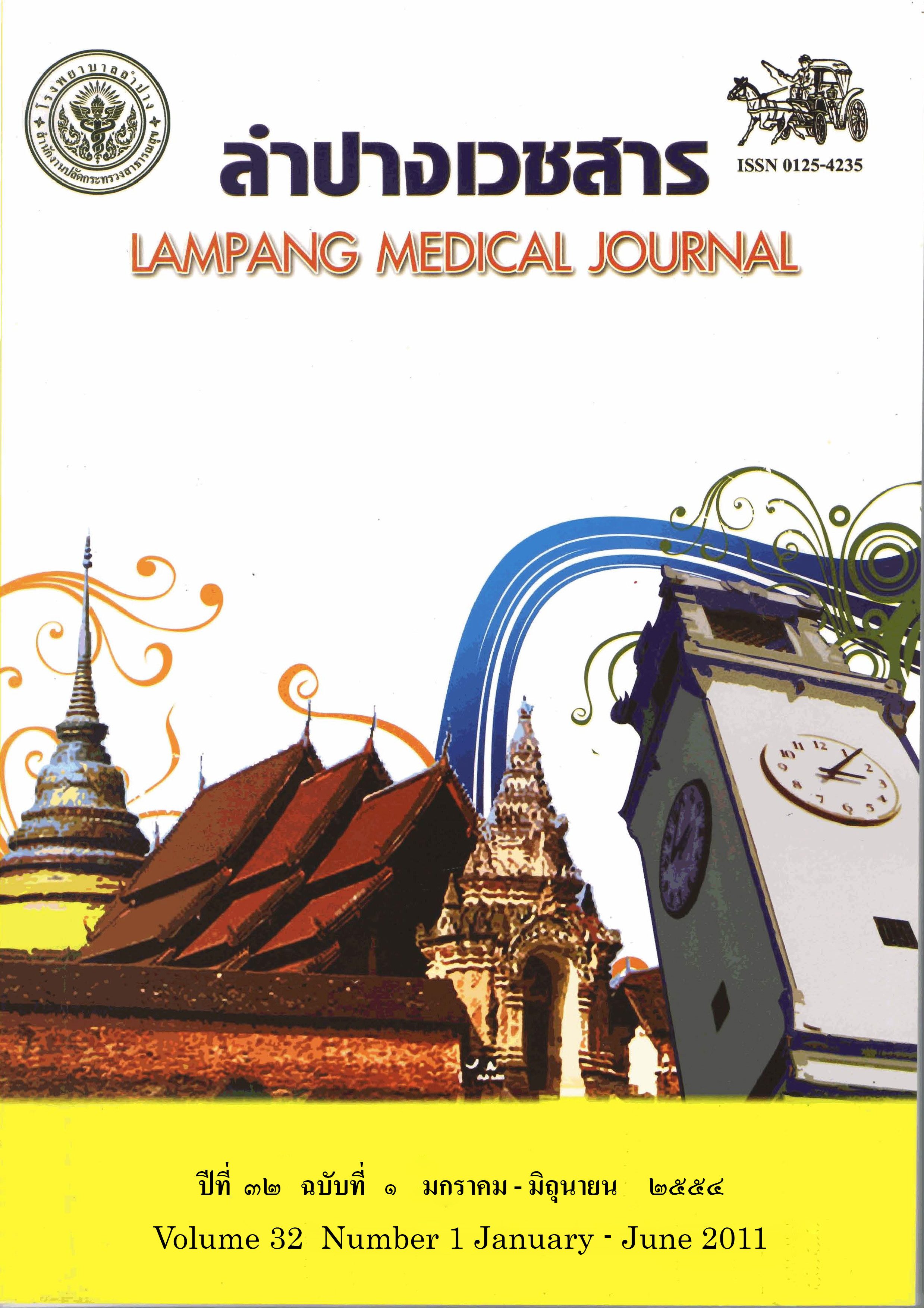Use of Quantitative Ultrasound Calcaneus Measurement for Identifying Osteoporosis in Thai Working-aged Women
Main Article Content
Abstract
Background : The standard method for diagnosing osteoporosis is dual energy x-ray absorptiometry (DXA) at T-score threshold of ≤ -2.5 SD by WHO criteria. DXA is relatively expensive and non-portable. Quantitative ultrasound (QUS) has been developed for bone mineral density (BMD) measurement with cheaper cost, portable and free from radiation. There is no consensus regarding to its accuracy for identifying osteoporosis especially at threshold of Tscore ≤ -2.5.
Objective : To determine the diagnostic performance of calcaneal QUS at T-score ≤ -2.0 for osteoporosis screening in Thai working-aged woman and compare with use of OSTA index.
Material and method : An analytic cross-sectional study was conducted in 137 voluntary Thai women aged ≤60 years who worked in Chiang Mai. Demographic data, body weight, height were recorded. Lumbar spine BMD was measured by DXA. Calcaneal BMD was measured by QUS and converted to T-score. DXA T-score ≤ -2.5 or QUS T-score ≤ -2.0 were defined as “osteoporosis”. The OSTA index was calculated. Women with scores ≤ -1 or scores ≤ 0 were classified as “high risk”. Diagnostic test analysis was obtained to compare each method.
Results : Mean age of the women was 49.9 ± 4.9 years (range, 28-60). Most of them aged between 50-60 years (63.5%) and had BMI 18.6-25.0 (66.4%). Thirty-eight cases had OSTA index ≤ 0 (28.7%). The prevalence of osteoporosis was 10.9% (14 cases). Using lumbar spine DXA as the gold standard, the sensitivity, specificity, positive predictive value, negative predictive value and likelihood ratio for positive test of calcaneal QUS measurement were 93.3%, 59.0%, 21.9%, 98.6% and 2.78 respectively. These accuracy indices were higher than OSTA index except specificity. Threshold of OSTA index ≤ 0 showed more accuracy than ≤ -1
to classify the high risk group.
Conclusion : Calcaneal QUS measurement at T-score ≤ -2.0 is reliable for osteoporosis screening in Thai working-aged women. Its accuracy is more than use of OSTA index. Results of QUS alone do not exclude or confirm DXA-determined osteoporosis.
Article Details

This work is licensed under a Creative Commons Attribution-NonCommercial-NoDerivatives 4.0 International License.
บทความที่ส่งมาลงพิมพ์ต้องไม่เคยพิมพ์หรือกำลังได้รับการพิจารณาตีพิมพ์ในวารสารอื่น เนื้อหาในบทความต้องเป็นผลงานของผู้นิพนธ์เอง ไม่ได้ลอกเลียนหรือตัดทอนจากบทความอื่น โดยไม่ได้รับอนุญาตหรือไม่ได้อ้างอิงอย่างเหมาะสม การแก้ไขหรือให้ข้อมูลเพิ่มเติมแก่กองบรรณาธิการ จะต้องเสร็จสิ้นเป็นที่เรียบร้อยก่อนจะได้รับพิจารณาตีพิมพ์ และบทความที่ตีพิมพ์แล้วเป็นสมบัติ ของลำปางเวชสาร
References
World Health Organization. Assessment of fracture risk and its application to screening for postmenopausal osteoporosis. No 843 of technical reports series, Geneva: WHO; 1994.
National Osteoporosis Foundation. Physician’s guide to prevention and treatment of osteoporosis 2003. Available at: http: www.nof.org/. Accessed June 25, 2006.
Richy F, Ethgen O, Bruyere O, Mawet A, Reginster JY. Primary prevention of osteoporosis mass screening scenario or prescreening with questionnaires? an economic perspective. J Bone Miner Res 2004; 19: 1955-60.
Koh LK, Sedrine WB, Torralba TP, Kung A, Fujiwara S, Chan SP, et al. A simple tool to identify asian women at increased risk of osteoporosis. Osteoporos Int 2001; 12: 699-705.
Greenspan SL, Bouxsein ML, Melton ME, Kolodny AH, Clair JH, Delucca PT, et al. Precision and discriminatory ability of calcaneal bone assessment technologies. J Bone Miner Res 1997; 12: 1303-13.
Nayak S, Olkin L, Liu H, Grabe M, Gould MK, Allen IE, et al. Meta-analysis: accessory of quantitative ultrasound for identifying patients with osteoporosis. Ann Intern Med 2006; 144: 832-41.
Marin F, Genzalez-Macias J, Diez-Perez A, Palma S, Delgado-Rodriguez M. Relationship between bone quantitative ultrasound and fractures: a meta-analysis. J Bone Miner Res 2006; 21: 1126-35.
Bauer DC, Gluer CC, Cauley JA, Vogt TM, Ensrud KE, Genant HK, et al. Broadband ultrasound attenuation predicts fractures strongly and independently of densitometry in older women: a prospective study. Arch Intern Med 1997; 157: 629-34.
Panichkul S, Sripramote M, Sriussawaamorn N. Diagnostic performance of quantitative ultrasound calcaneus measurement in case finding for osteoporosis in Thai postmenopausal women. J Obstet Gynaecol Res 2004; 30: 418-26.
Frost ML, Blake GM, Fogelman I. Can the WHO criteria for diagnosing osteoporosis be applied to calcaneal quantitative ultrasound?. Osteoporos Int 2000; 11: 321-30.
Lippuner K, Fuchs G, Ruetsche AG, Perrelet R, Casez JP, Neto I. How well do radiographic absorptiometry and quantitative ultrasound predict osteoporosis at spine or hip? a cost-effectiveness analysis. J Clin Densitom 2000; 3: 241-9.
Cetin A, Erturk H, Celiker R, Sivri A, Hascelik Z. The role of quantitative ultrasound in predicting osteoporosis defined by dual x-ray absorptiometry. Rheumatol Int 2001; 20: 55-9.
Frost ML, Blake GM, Fogelman I. Does quantitative ultrasound imaging enhance precision and discrimination?. Osteoporos Int 2000; 11: 425-33.
Pongchaiyakul C, Panichkul S, Songpatanasilp T. Combined clinical risk indices with quantitative ultrasound calcaneus measurement for identifying osteoporosis in Thai postmenopausal women. J Med Assoc Thai 2007; 90: 2016-23.
Soontrapa S, Soontrapa S, Chaikitpinyo S. Using quantitative ultrasound and OSTA index to increase the efficacy and decrease the cost for diagnosis of osteoporosis. J Med Assoc Thai 2009; 92 Suppl5: S49-53.
Irwig L, Tosteson AN, Gatsonis C, Lau J, Colditz G, Chalmers TC, et al. Guidelines for meta-analyses evaluating diagnostic tests. Ann Intern Med 1994; 120: 667–76.
Geater S, Leelawattana R, Geater A. Validation of the OSTA index for discriminating between high and low probability of femoral neck and lumbar spine osteoporosis among Thai postmenopausal women. J Med Assoc Thai 2004; 87:1286-92.


